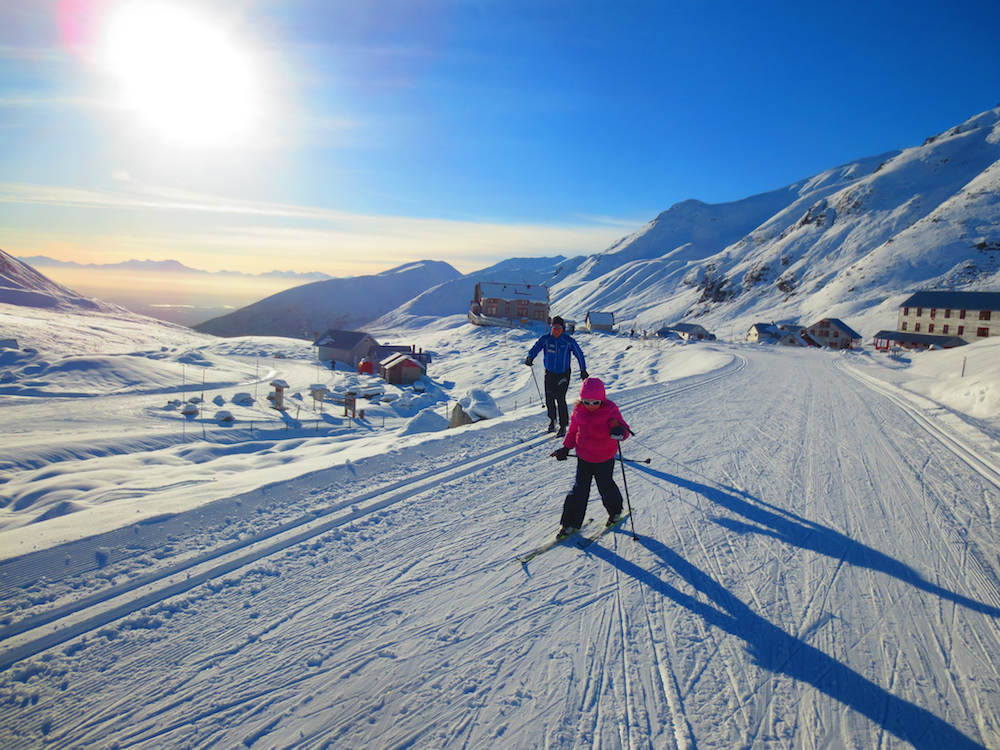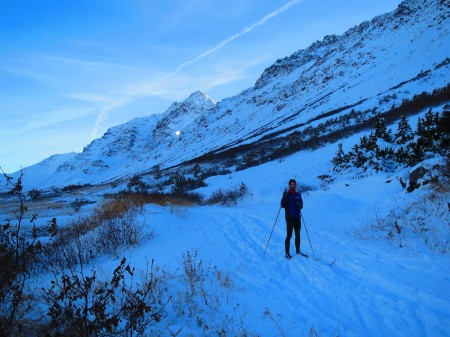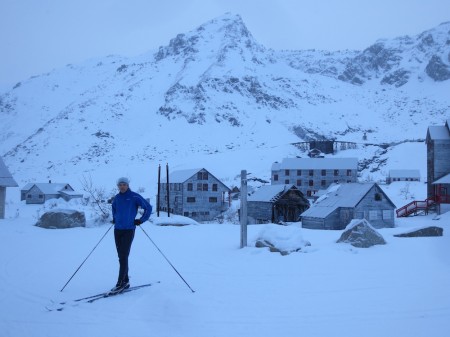
Masters from around the world, we want to hear from you! FasterSkier is seeking dedicated masters contributors from various clubs and regions, including any and all skiers who aren’t quite pro or collegiate skiers anymore (or ever — as we know how many catch the bug later in life!) Whatever your level of skiing, if you can write, please do!
Submit camp or training recaps or announcements to info@fasterskier.com with the subject line “Masters Minds”. Articles can be informal, first-person accounts or written from an observatory standpoint with thoughts from others, like below.
***
Part of the joy and the pain and, ultimately, the poetry of a lifetime of skiing is how the sport focuses one’s attention on natural processes that are both cyclical and unpredictable. This year Southcentral Alaska caught its first real snow on Oct. 20, and early season skiing has been great, but not in the usual ways or places.
First grooming honors go to the Nordic Ski Association of Anchorage, who, thanks to extensive summer trail work and an innovative approach with a light homemade drag pulled by an ATV, miraculously transformed a scant four inches into fine skiing at the Hillside Park in Anchorage. A few more inches fell higher up, in Chugach State Park, where early-season skiers along Powerline Pass witnessed a pair of grizzly bears fighting over a dead bull moose.
Skiing has also been good south of Anchorage in the resort town of Girdwood, where a beautiful and challenging new 5 k system winds among stately hemlocks in a spectacular mountain valley. Completely absent from the scene, however, has been Southcentral Alaska’s traditional go-to early season hotspot, Hatcher Pass, which has missed the region’s minimal early snow thus far. Nonetheless, as if by habit, masters’ minds and talk have turned frequently of late to this special place.
Completely absent from the scene, however, has been Southcentral Alaska’s traditional go-to early season hotspot, Hatcher Pass, which has missed the region’s minimal early snow thus far.
There must be many spectacular snow bowls high in Alaska’s Talkeetna Mountains, where remnant Pacific storm systems (usually!) roll like slow breakers into jagged peaks and arctic chill, but only one such wonderland, Hatcher Pass, is accessible via a plowed road, and it is a goldmine. And an actual gold mine.

The surrounding mountains are born of the Castle Mountain Fault, a major geological fracture the access road crosses, much lower, as it begins to climb through the canyon of the Little Susitna River, but the road itself owes its existence to Robert Hatcher’s discovery of gold in the area in 1906 and the subsequent development of Independence Mine, in its heyday a vibrant industrial complex served by miles of tunnels and over 200 employees, some of whom took advantage of the area’s excellent skiing, both for fun and transportation.
Independence Mine closed in 1951 but the skiing continued, with skiers often staying in the abandoned buildings. In the late 1960s Hap Wurlitzer opened the incomparable Hatcher Pass Lodge about one kilometer below the mine complex, and the onetime mine manger’s house, built in 1936 for the Stoll family, also served for a time in the 1970s as a skiers’ inn.
In 1974 the mine was placed on National Register of Historical Places, and since 1980 the buildings and surrounding 270 acres comprise Independence Mine State Historical Park. Grand plans for enormous ski resorts at Hatcher Pass have never materialized, thankfully. Today, thanks to incredible grooming by the Mat-Su Ski Club, skiing is hotter than ever. Early-season skiing at Independence Mine is easily among the best in America and a beloved southcentral Alaskan fall ritual.
The 800-foot climb from Hatcher Pass Lodge at the end of the road up to the historic mine seems an important part of that ritual for many Alaskan masters and a good gauge of fall fitness, if a bit of a rough welcome back to snow. At the mine, three interconnected loops totaling several kilometers, zero meters of which are horizontal, weave amid clapboard buildings, the mess hall, offices and machine shops, dormitories, all painted silver with red trim, some three stories tall, many with covered porches, and fascinating ruins, including crumbling mine car trestles, waterways, and enormous generators. Imagine skiing through an Old West ghost town turned collectible Christmas village.
Imagine skiing through an Old West ghost town turned collectible Christmas village.
Skiing at Independence Mine is typically excellent season-long, but it’s busiest in the fall, as many area skiers take the opportunity for an early start on challenging terrain.

Longtime Alaska Pacific University Nordic Center (APUNC) Masters coach Dylan Watts advises, “You can normally add three to four weeks to your ski session if you’re willing to make the drive. This makes it ideal for getting a feel for the snow and skis again. Plus the kilometer-long uphill right at the start really gives a boost to your fitness. After a few weekends skiing up and down you can feel an improvement both in confidence and ability on the skis as well as improved strength and stamina. The area also offers a variety of consistent grades both on straights and turns all within a compact area, making it ideal for working on different techniques and skills. It really is an ideal place if you’re looking to build form and fitness on cross-country skis.”
Mike Truskowski, M5 racer, middle-school teacher and coach, adds: “To make things even more interesting, there is no place to hide from your friends, so everyone can see how you’re doing. Just when you think that you’re skiing a good loop, watch out behind you: That person calling ‘Hup ’ could be an Olympic skier, a national champion, or just your buddy who worked harder than you this last summer.”
That buddy might be M4 racer and Anchorage optometrist Jim Falconer who also enjoys the challenge and the area’s special beauty: “A ski at Independence Mine in October usually marks the beginning of the ski season for me. After the season’s first significant snow in the mountains, it’s an almost spiritual experience to go up there and ski in that environment — it feels like another world. And since it’s mostly up and down without much in the way of flat terrain, skiing there is a real test of the fitness you are carrying into the ski season from your summer training.”

According to Mat-Su Ski Club President Ed Strabel, over the past nine years, grooming at Independence mine has begun on a mean date of Oct. 13. Strabel, father of Mount Marathon champion Eric Strabel, and his ski club colleagues are passionate about spinning frequent heavy snowfalls into set tracks and corduroy.
“Our dedicated all volunteer, unpaid groomers do most of the grooming at night to give the snow time to setup before the skiers arrive,” Strabel says. “While our tracked ATV’s are vastly superior to a snowmachines for grooming, big snowfalls (over 12 inches) are a challenge and the trail will be a bit punchy because we can’t get the pounds per square inch of a PistenBully. Wind can also be a big headache because we don’t have a six-way blade to take out drifts. Last year we had a 30″ snowfall followed by high winds. The whole area was almost featureless.”
But such devotion isn’t completely altruistic: “All our groomers are skiers, too, and we want to ski also,” he adds, “The toughest part our volunteer groomers have to cope with, other than getting a groomer unstuck, is resisting the urge to grab our skis and go skiing on our handy work immediately after we finish grooming.”
While it’s true that the light can be flat, the weather awful, the kick waxing weird, skiing at Independence Mine is always an exceptional experience. On a clear day, the views and surrounding mountains are mind-bendingly beautiful. The old mine is interesting in any weather. Maybe best of all, those first few weekends back on skis up there are in many ways a reunion, or re-formation, of our community, from masters to kids to Olympians, and everyone is smiling.
While it’s true that the light can be flat, the weather awful, the kick waxing weird, skiing at Independence Mine is always an exceptional experience.
When asked via email what he thinks about when he thinks about skiing Independence Mine, Coach Watts’ answer is perhaps evocative enough and instructive enough to quote in full and call it good:
“For me I really like the uniqueness of skiing at a historic hard rock mine. Skiing around the old buildings, it is hard not to let the mind reflect on the history of the mine, the miles of tunnels dug with great labor chasing gold. Kick, glide, kick, glide. The process that put that gold in place. Keep the arms pumping. On to the history and future of resource development in Alaska. Dance off the feet as you herring bone the steep hill. Then on to the beauty of the peaks all around. Watch the plowed-up snow in the corner. The ubiquitous of petroleum products on every person out skiing: clothing, skis, wax, boots. Tuck lower. Watching people ski up as I fly down the hill. They look fit. How nice to see the whole family out skiing. Must be the first day on skis for them. Kick up some spray at the bottom to show off a little. Back to kick, glide, kick, glide. It is pretty easy to have three hours of hard skiing fly by and let the mind mediate, wonder, and marvel at the world and life on it.”
***
About the Author: Shannon Gramse is a longtime member of APU Nordic Ski Center’s Masters Program. When he’s not skiing, he’s thinking about skiing while being a father and a husband and a professor at the University of Alaska Anchorage.




One comment
gkentch
November 4, 2014 at 4:45 pm
Well, this is just about the most lyrical thing I’ve ever seen on FS.